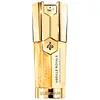What's inside
What's inside
 Key Ingredients
Key Ingredients

No key ingredients
 Benefits
Benefits

 Concerns
Concerns

 Ingredients Side-by-side
Ingredients Side-by-side

Water
Skin ConditioningGlycerin
HumectantPropanediol
SolventButylene Glycol
HumectantAlcohol
AntimicrobialEthylhexyl Stearate
EmollientPentylene Glycol
Skin ConditioningPropylene Glycol Dicaprylate/Dicaprate
EmollientTapioca Starch
Royal Jelly
Coco-Caprylate/Caprate
EmollientCellulose
AbsorbentSoybean Glycerides
EmollientHydroxyethyl Acrylate/Sodium Acryloyldimethyl Taurate Copolymer
Emulsion StabilisingSteareth-21
CleansingSynthetic Fluorphlogopite
Mel
EmollientBis-Behenyl/Isostearyl/Phytosteryl Dimer Dilinoleyl Dimer Dilinoleate
EmollientStearyl Alcohol
EmollientCI 77891
Cosmetic ColorantButyrospermum Parkii Butter Unsaponifiables
Skin ConditioningSorbitol
HumectantCetyl Alcohol
EmollientMel Extract
MoisturisingSteareth-2
EmulsifyingParfum
MaskingChlorphenesin
AntimicrobialCaprylyl Glycol
EmollientPolyglyceryl-10 Stearate
Skin ConditioningMangifera Indica Seed Butter
Skin ConditioningPolyglycerin-4
HumectantWater, Glycerin, Propanediol, Butylene Glycol, Alcohol, Ethylhexyl Stearate, Pentylene Glycol, Propylene Glycol Dicaprylate/Dicaprate, Tapioca Starch, Royal Jelly, Coco-Caprylate/Caprate, Cellulose, Soybean Glycerides, Hydroxyethyl Acrylate/Sodium Acryloyldimethyl Taurate Copolymer, Steareth-21, Synthetic Fluorphlogopite, Mel, Bis-Behenyl/Isostearyl/Phytosteryl Dimer Dilinoleyl Dimer Dilinoleate, Stearyl Alcohol, CI 77891, Butyrospermum Parkii Butter Unsaponifiables, Sorbitol, Cetyl Alcohol, Mel Extract, Steareth-2, Parfum, Chlorphenesin, Caprylyl Glycol, Polyglyceryl-10 Stearate, Mangifera Indica Seed Butter, Polyglycerin-4
Water
Skin ConditioningGlycerin
HumectantButylene Glycol
HumectantAluminum Starch Octenylsuccinate
AbsorbentCetearyl Alcohol
EmollientIsododecane
EmollientIsostearyl Neopentanoate
EmollientButyrospermum Parkii Butter
Skin ConditioningPentylene Glycol
Skin ConditioningPEG-8
HumectantOryza Sativa Powder
Squalane
EmollientIpomoea Batatas Root Extract
Skin ConditioningMedicago Sativa Extract
TonicSaccharomyces Cerevisiae Extract
Skin ConditioningCera Alba
EmollientJojoba Esters
EmollientDipropylene Glycol
HumectantGlyceryl Stearate
EmollientPEG-100 Stearate
Sodium Carbomer
Emulsion StabilisingCetearyl Glucoside
EmulsifyingTocopheryl Acetate
AntioxidantChlorphenesin
AntimicrobialHydrolyzed Soy Protein
HumectantCaprylyl Glycol
EmollientPhospholipids
Skin ConditioningSodium Acrylates/C10-30 Alkyl Acrylate Crosspolymer
Escin
TonicPhenoxyethanol
PreservativeSodium Citrate
BufferingBeta-Sitosterol
Emulsion StabilisingBiosaccharide Gum-1
HumectantPolyquaternium-51
Skin ConditioningSodium Polyacrylate
AbsorbentAdenosine
Skin ConditioningSodium Hyaluronate
HumectantPhytic Acid
Polysorbate 20
EmulsifyingEthylhexylglycerin
Skin ConditioningHydrochloric Acid
BufferingTocopherol
AntioxidantPalmitoyl Tripeptide-1
Skin ConditioningPalmitoyl Tetrapeptide-7
Skin ConditioningSodium Benzoate
MaskingCitric Acid
BufferingWater, Glycerin, Butylene Glycol, Aluminum Starch Octenylsuccinate, Cetearyl Alcohol, Isododecane, Isostearyl Neopentanoate, Butyrospermum Parkii Butter, Pentylene Glycol, PEG-8, Oryza Sativa Powder, Squalane, Ipomoea Batatas Root Extract, Medicago Sativa Extract, Saccharomyces Cerevisiae Extract, Cera Alba, Jojoba Esters, Dipropylene Glycol, Glyceryl Stearate, PEG-100 Stearate, Sodium Carbomer, Cetearyl Glucoside, Tocopheryl Acetate, Chlorphenesin, Hydrolyzed Soy Protein, Caprylyl Glycol, Phospholipids, Sodium Acrylates/C10-30 Alkyl Acrylate Crosspolymer, Escin, Phenoxyethanol, Sodium Citrate, Beta-Sitosterol, Biosaccharide Gum-1, Polyquaternium-51, Sodium Polyacrylate, Adenosine, Sodium Hyaluronate, Phytic Acid, Polysorbate 20, Ethylhexylglycerin, Hydrochloric Acid, Tocopherol, Palmitoyl Tripeptide-1, Palmitoyl Tetrapeptide-7, Sodium Benzoate, Citric Acid
Ingredients Explained
These ingredients are found in both products.
Ingredients higher up in an ingredient list are typically present in a larger amount.
Butylene Glycol (or BG) is used within cosmetic products for a few different reasons:
Overall, Butylene Glycol is a safe and well-rounded ingredient that works well with other ingredients.
Though this ingredient works well with most skin types, some people with sensitive skin may experience a reaction such as allergic rashes, closed comedones, or itchiness.
Learn more about Butylene GlycolCaprylyl Glycol is a humectant and emollient, meaning it attracts and preserves moisture.
It is a common ingredient in many products, especially those designed to hydrate skin. The primary benefits are retaining moisture, skin softening, and promoting a healthy skin barrier.
Though Caprylyl Glycol is an alcohol derived from fatty acids, it is not the kind that can dry out skin.
This ingredient is also used as a preservative to extend the life of products. It has slight antimicrobial properties.
Learn more about Caprylyl GlycolChlorphenesin is a synthetic preservative. It helps protect a product against bacteria in order to extend shelf life. In most cases, Chlorphenesin is paired with other preservatives such as phenoxyethanol and caprylyl glycol.
Chlorphenesin is a biocide. This means it is able to help fight the microorganisms on our skin. It is also able to fight odor-releasing bacteria.
Chlorphenesin is soluble in both water and glycerin.
Studies show Chlorphenesin is easily absorbed by our skin. You should speak with a skincare professional if you have concerns about using Chlorphenesin.
Learn more about ChlorphenesinGlycerin is already naturally found in your skin. It helps moisturize and protect your skin.
A study from 2016 found glycerin to be more effective as a humectant than AHAs and hyaluronic acid.
As a humectant, it helps the skin stay hydrated by pulling moisture to your skin. The low molecular weight of glycerin allows it to pull moisture into the deeper layers of your skin.
Hydrated skin improves your skin barrier; Your skin barrier helps protect against irritants and bacteria.
Glycerin has also been found to have antimicrobial and antiviral properties. Due to these properties, glycerin is often used in wound and burn treatments.
In cosmetics, glycerin is usually derived from plants such as soybean or palm. However, it can also be sourced from animals, such as tallow or animal fat.
This ingredient is organic, colorless, odorless, and non-toxic.
Glycerin is the name for this ingredient in American English. British English uses Glycerol/Glycerine.
Learn more about GlycerinPentylene glycol is typically used within a product to thicken it. It also adds a smooth, soft, and moisturizing feel to the product. It is naturally found in plants such as sugar beets.
The hydrophilic trait of Pentylene Glycol makes it a humectant. As a humectant, Pentylene Glycol helps draw moisture from the air to your skin. This can help keep your skin hydrated.
This property also makes Pentylene Glycol a great texture enhancer. It can also help thicken or stabilize a product.
Pentylene Glycol also acts as a mild preservative and helps to keep a product microbe-free.
Some people may experience mild eye and skin irritation from Pentylene Glycol. We always recommend speaking with a professional about using this ingredient in your routine.
Pentylene Glycol has a low molecular weight and is part of the 1,2-glycol family.
Learn more about Pentylene GlycolWater. It's the most common cosmetic ingredient of all. You'll usually see it at the top of ingredient lists, meaning that it makes up the largest part of the product.
So why is it so popular? Water most often acts as a solvent - this means that it helps dissolve other ingredients into the formulation.
You'll also recognize water as that liquid we all need to stay alive. If you see this, drink a glass of water. Stay hydrated!
Learn more about Water